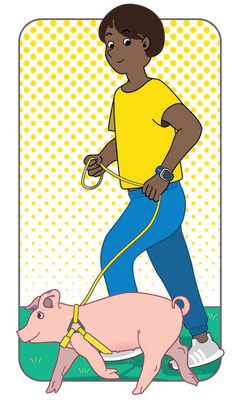When a client has one pig, they often accumulate more, according to Emily Barrell, DVM, MSc, DACVIM. “You can’t just have one!” she says.
Barrell did a mixed animal residency at Cornell University. There, she first began seeing porcine patients—and fell in love with them. In January, she joined the University of Minnesota College of Veterinary Medicine (CVM) faculty. With the rise in pet hog and potbellied pig cases at the CVM’s Large Animal Hospital, Barrell has had many opportunities to continue treating her favorite patients. “Their owners are really invested in their care,” she says.
But why have these porcine pets become so sought-after? “They are roughly as smart as a three-year-old toddler—you can teach them even more than a dog, in some cases,” says Barrell. Owners can housebreak and leash train their pigs. The squiggly tailed pals can even learn tricks.
With the rising demand for these pets, it’s increasingly important for owners to understand the necessity of routine care. Contrary to popular belief, pigs need a nutritious and strict diet to stay fit. They have difficulty losing excess weight, and obesity can cause foot or joint disease and breathing problems. Teeth cleaning, nail care, and vaccines are also vital.
Healthy pet pigs and hogs can live up to 20 years. And according to Barrell, their owners are grateful for quality care. These clients are frequently turned away by veterinarians who don’t work on pet pigs often enough to know how to help. “I always tell students that if you are up front with your clients and you tell them you are willing to at least try, you have likely earned a client for life.”
For Barrell and the veterinarians at the Large Animal Hospital, there is much excitement for the future of continuing to treat pigs and hogs. “They are not dogs—there are a lot of things they need in order to thrive, and I am looking forward to working with clients and referral vets.”
Illustration by Hairun Li

